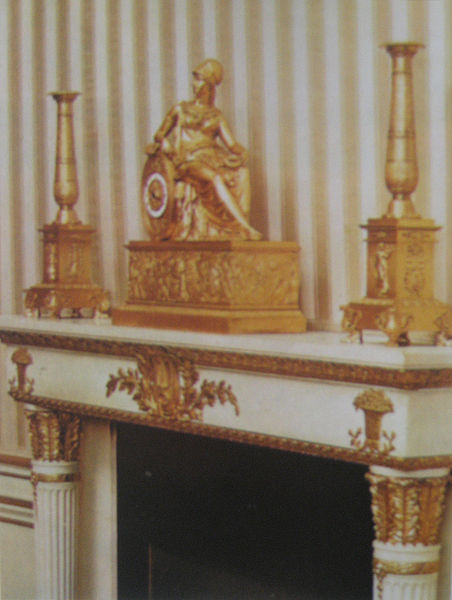Pierre-Philippe Thomire (1751–1843) a French sculptor, was the most prominent bronzier, or producer of ornamental patinated and gilt-bronze objects and furniture mounts of the First French Empire. His fashionable neoclassical and Empire style furnishing bronzes established the highest standard in refined finish in the craft that the French called that of the fondeur-ciseleur, "founder-finisher". In his pre-Revolutionary training, Thomire appeared first as a ciseleur, in the division of duties that went into the production, for example, of a set of gilt-bronze wall-lights delivered for Marie-Antoinette's card-room, her Salon des Jeux at Compiègne: under the general supervision of Hauré, the wax and wooden model was carved by Martin, cast by Forestier, and chased by Thomire, as Pierre Verlet was able to show over fifty years ago.

Baluster candle sticks and a French Empire mantel clock with a figure of Minerva, (1817). Located in the Blue Room of the White House, shown as decorated by Stéphane Boudin in 1963. The clock is now on a table of the Entrance Hall.
Mantel clock (c. 1810) in a gilded and patinated bronze case, symbolising the marriage of Napoleon and the Archduchess Marie-Louise, as Mars and Venus
Ormolu is the gilding technique of applying finely ground, high-carat gold–mercury amalgam to an object of bronze, and objects finished in this way. The mercury is driven off in a kiln, leaving behind a gold coating. The French refer to this technique as "bronze doré"; in English, it is known as "gilt bronze". Around 1830, legislation in France outlawed the use of mercury for health reasons, though use continued to the 1900s.
A garniture of an ormolu clock and candelabra at the Palace of Versailles in France
Bowl Mounted with Two Fish; bowl: 1730–1740, fishes: early 18th century, mounts: 1745–1749; porcelain with glaze monochrome turquoise/light blue and French ormolu mounts; 18.7 cm; Walters Art Museum (Baltimore, US)
Patinated and ormolu Empire timepiece representing Mars and Venus, an allegory of the wedding of Napoleon I and Archduchess Marie Louise of Austria in 1810; by the famous bronzier Pierre-Philippe Thomire; circa 1810; gilded bronze and patina; height: 90 cm; Louvre
Clock ornament; 18th century; gilt-bronze; overall: 9.2 × 8.9 × 1.9 cm; Metropolitan Museum of Art (New York City)





